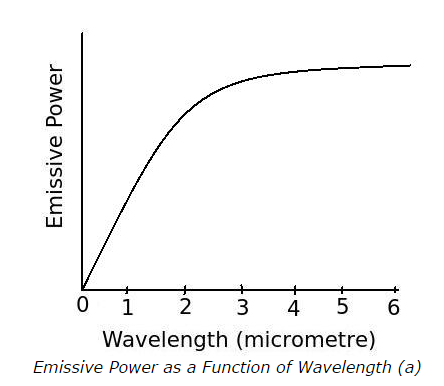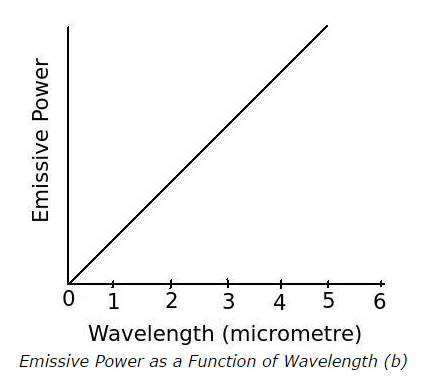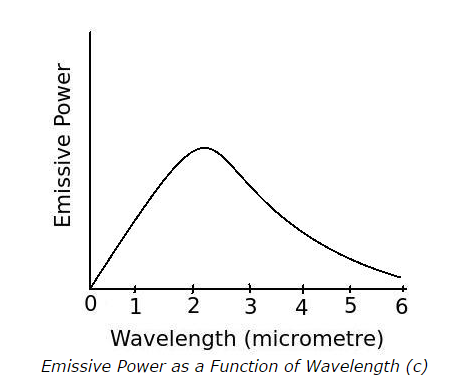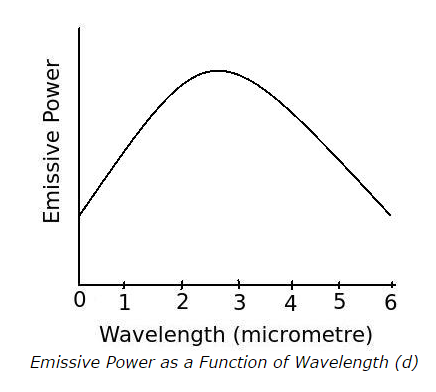Radiation Properties – MCQs with Answers
1. What is emissive power of a body?a. total radiation emitted by the body per unit volume and time
b. total radiation emitted by the body per unit temperature and time
c. total radiation emitted by the body per unit area and time
d. none of the above
View Answer / Hide Answer ANSWER: c. total radiation emitted by the body per unit area and time
2. The emissive power of a body depends upona. temperature of the the body
b. characteristics of the surface of the body
c. both a. and b.
d. none of the above
View Answer / Hide Answer ANSWER: c. both a. and b.
3. At a given temperature if wavelengths are changed, the quality of radiation per unit wavelengtha. will always be constant
b. will also be changed
c. will be changed sometimes but sometimes be constant
d. unpredictable
View Answer / Hide Answer ANSWER: b. will also be changed
4. How is the relation between emissive power of a body and the radiation wavelength represented for an ideal radiator at a given temperature say 1900 K?a.

b.

c.

d.
 View Answer / Hide Answer 5. What is the relation between temperature of a body and the wavelength of its emitted radiation at its maximum emissive power?
View Answer / Hide Answer 5. What is the relation between temperature of a body and the wavelength of its emitted radiation at its maximum emissive power?a. as temperature of a body increases the wavelength of its emitted radiation also increases at its maximum emissive power
b. as temperature of a body increases the wavelength of its emitted radiation decreases at its maximum emissive power
c. as temperature of a body increases the wavelength of its emitted radiation does not change only at its maximum emissive power
d. none of the above
View Answer / Hide Answer ANSWER: b. as temperature of a body increases the wavelength of its emitted radiation decreases at its maximum emissive power
6. Which of the following relation is correct for the radiation?a. [Incident Radiation] + [Absorbed Radiation] = [Reflected Radiation] + [Transmitted Radiation]
b. [Incident Radiation] + [Transmitted Radiation] = [Reflected Radiation] + [Absorbed Radiation]
c. [Incident Radiation] = [Reflected Radiation] + [Absorbed Radiation] + [Transmitted Radiation]
d. [Absorbed Radiation] = [Reflected Radiation] + [Transmitted Radiation] + [Incident Radiation]
View Answer / Hide Answer ANSWER: c. [Incident Radiation] = [Reflected Radiation] + [Absorbed Radiation] + [Transmitted Radiation]
7. What is the relation between reflectivity (ρ), absorptivity (α) and transmissivity (τ)?a. ρ – α + τ = 1
b. ρ + α – τ = 1
c. ρ + α + τ = 1
d. ρ – α – τ = 1
View Answer / Hide Answer 8. What is the opaque body?a. the body which does not reflect radiation
b. the body which does not absorb radiation
c. the body which does not transmit radiation
d. all of the above
View Answer / Hide Answer ANSWER: c. the body which does not transmit radiation
9. What is diffuse reflection of radiation?a. the reflection of radiation on a rough surface which occurs in all directions
b. the reflection of radiation on a rough surface which occurs in a single direction
c. the reflection of radiation on a smooth surface
d. none of the above
View Answer / Hide Answer ANSWER: a. the reflection of radiation on a rough surface which occurs in all directions
10. The reflection in which the angle of incident is equal to the angle of reflection is called asa. regular reflection
b. specular reflection
c. both a. and b.
d. none of the above
View Answer / Hide Answer ANSWER: c. both a. and b.
11. The values of reflectivity (ρ), absorptivity (α) and transmissivity (τ) of a body are depend upona. material of the body
b. surface condition of the body
c. wavelength of radiation
d. all of the above
View Answer / Hide Answer ANSWER: d. all of the above